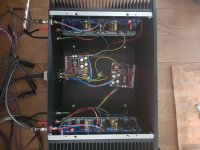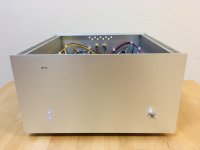It seems that I've blown the zener diodes. I think the pots were all the way up instead of down so now I'm waiting for new diodes to come from RS.
On the plus side I managed to cobble together 3 resistors in series to get 27.3k on it did indeed give me the range to get the 130mv.
On the plus side I managed to cobble together 3 resistors in series to get 27.3k on it did indeed give me the range to get the 130mv.
Aaaaaargh!
I discovered that I swapped the diodes round by accident!
I know it damaged the zener diodes. But, can anyone say what other damage I may have caused?
There was no smoke or charring. I'd love to hear any thoughts.
I discovered that I swapped the diodes round by accident!
I know it damaged the zener diodes. But, can anyone say what other damage I may have caused?
There was no smoke or charring. I'd love to hear any thoughts.
Cheers gents.
Dennis. I think, pretty sure in fact, that P1/P2 were at max when I first powered up (with a lightbulb limiter).
I won't get the new zeners till Tuesday.
Dennis. I think, pretty sure in fact, that P1/P2 were at max when I first powered up (with a lightbulb limiter).
I won't get the new zeners till Tuesday.
F4 running on two SMPS300RAh -/+23V from connexelectronic (soft start already built in). One unit per channel.
200mV bias. None of the electronic components (both smps nor transistors) exceeding 50 degrees (celcius) in 5U/300mm chassis.
I will compare it to traditional transformer + caps sometime soon ... but so far I have no motivation, because it sounds amazing! The sound integration and continuity is just phenomenal. Especially different bass layers and top end!
It is driven by 2xad1865 dac (transformer I/V out) directly. No additional gain needed for my needs on TQWT MKIII speakers.

200mV bias. None of the electronic components (both smps nor transistors) exceeding 50 degrees (celcius) in 5U/300mm chassis.
I will compare it to traditional transformer + caps sometime soon ... but so far I have no motivation, because it sounds amazing! The sound integration and continuity is just phenomenal. Especially different bass layers and top end!
It is driven by 2xad1865 dac (transformer I/V out) directly. No additional gain needed for my needs on TQWT MKIII speakers.

Last edited:
F4 running on two SMPS300RAh -/+23V from connexelectronic (soft start already built in). One unit per channel.
200mV bias. None of the electronic components (both smps nor transistors) exceeding 50 degrees (celcius) in 5U/300mm chassis.
I will compare it to traditional transformer + caps sometime soon ... but so far I have no motivation, because it sounds amazing! The sound integration and continuity is just phenomenal. Especially different bass layers and top end!
It is driven by 2xad1865 dac (transformer I/V out) directly. No additional gain needed for my needs on TQWT MKIII speakers.
View attachment 854744
Great work! IMHO, it just doesn't get better than this with SS amplification.
Wow, that really illustrates the point of how small and efficient a switching power can be vs a traditional transformer and bulk capacitance.
Interesting idea for the source resistors too, not seen that done before...
Interesting idea for the source resistors too, not seen that done before...
Finished up an F4 few days ago.
It may sound different from original design, because I use japanese audio grade parts. Anyway It sounds good. Really good.
Thank you 6L6, Nelson.
Nice r core!
Finished up an F4 few days ago.
It may sound different from original design, because I use japanese audio grade parts. Anyway It sounds good. Really good.
Thank you 6L6, Nelson.
Really nice and clean, great work!!!
Finished up an F4 few days ago.
It may sound different from original design, because I use japanese audio grade parts. Anyway It sounds good. Really good.
Thank you 6L6, Nelson.
Really nice build! Congrats!
Mpc74 resistors are also very nice, I wonder whether it has been a challenge to measure the bias of individual mosfets as the reaiators sit very close to pcb?
I discovered my local electronic store has MPC71 .47 ohm resistors and I use them on all my Pass builds and I like them a lot. I buy so many of them they give them to me half price at $0.50 each.
Bad news 🙁F4 running on two SMPS300RAh -/+23V from connexelectronic (soft start already built in). One unit per channel.
200mV bias. None of the electronic components (both smps nor transistors) exceeding 50 degrees (celcius) in 5U/300mm chassis.
I will compare it to traditional transformer + caps sometime soon ... but so far I have no motivation, because it sounds amazing! The sound integration and continuity is just phenomenal. Especially different bass layers and top end!
It is driven by 2xad1865 dac (transformer I/V out) directly. No additional gain needed for my needs on TQWT MKIII speakers.
View attachment 854744
Although those SMPS were designed for continuous current of Class A amps, after couple of days of playback one of the SMPS failed 🙁 Fortunately they are -/+, so both rails at the same time. Nothing happened to F4 Module nor to my speakers.
No I got my motivation to go with traditional approach: transformer and caps 🙂
On the other hand those units are very good. I used them with success and no issue with many Class AB amps. Either I had bad luck and received faulty one this time or F4 is simply too power demanding for them, especially @ 200mV bias.
Last edited:
why these
May I ask what the differences are between the MPC71 and, say, vishay dale RN / CMF resistor?
I already got that they're metal plate compared to metal film, but what could I conclude from that?
Thank you
david
… japanese audio grade parts …
MPC71 .47 ohm resistors and I use them on all my Pass builds.
May I ask what the differences are between the MPC71 and, say, vishay dale RN / CMF resistor?
I already got that they're metal plate compared to metal film, but what could I conclude from that?
Thank you
david
Last edited:
Very nice build! May I ask which bridge rectifiers are used? MPC 74 and MPC 78 are special for audio use according to the datasheet.
I got my f4 up n running this evening. So, again, thanks to all who chipped in. Many thanks.
I got my diodes changed. Jim, you were right, no other damage.
I'm running at 175mv and it sounds breathtaking. I mean, like, whaaaaaat!
Plàyed 2 LP's. An acoustic guitar and single voice and DSOTM.
S#@T MAN, this thing is nuts, a big leap in imaging compared to the F5. Just fantastic. I'm going to bed, I feel like a kid at Christmas. I can't wait to get up and play records all day.
I got my diodes changed. Jim, you were right, no other damage.
I'm running at 175mv and it sounds breathtaking. I mean, like, whaaaaaat!
Plàyed 2 LP's. An acoustic guitar and single voice and DSOTM.
S#@T MAN, this thing is nuts, a big leap in imaging compared to the F5. Just fantastic. I'm going to bed, I feel like a kid at Christmas. I can't wait to get up and play records all day.
- Home
- Amplifiers
- Pass Labs
- A guide to building the Pass F4 amplifier


